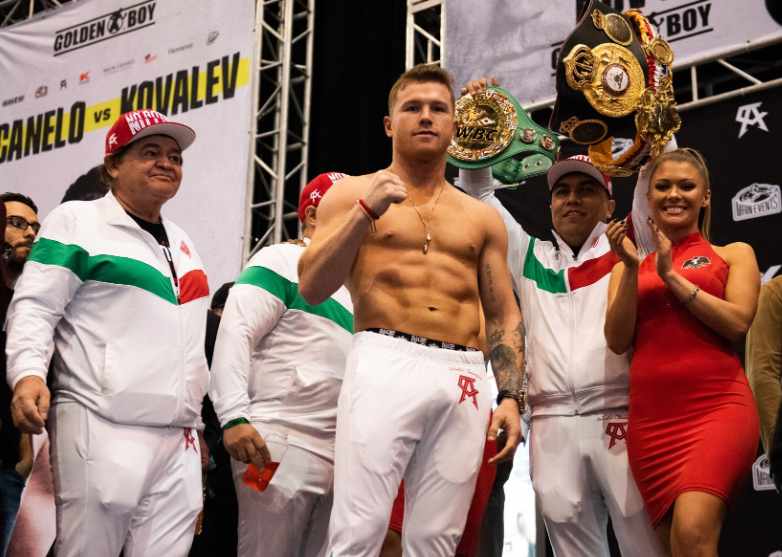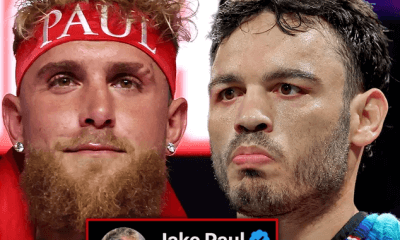Featured Articles
Avila Perspective, Chap. 72: Pound for Pound King, Matchroom in L.A. and More

Saul “Canelo” Alvarez has slowly climbed up the ladder regarding elite status in the prizefighting arena, and now I feel confident in saying he belongs at the top of the mythical pound for pound list.
Alvarez’s win over Sergey “Krusher” Kovalev by knockout to win the WBO light heavyweight world title was a daring feat especially considering the physical dimensions of both fighters. The Russian champion had more than four inches in height advantage and a proven history of bludgeoning opponents.
Over the course of history, many shorter fighters dared move up the weight divisions to challenge the much bigger man. More often than not, they were shut down rudely, but a few come to mind that most fans don’t know about.
One of my favorite fighters to read about was Sam Langford the old “Boston Bonecrusher” who had more than 178 wins in more than 200 pro fights from 1902 to 1926. He was about the same size as Canelo and fought from 135-pound lightweight to heavyweight including a challenge against the great heavyweight champion Jack Johnson in 1906 which he lost by decision after 15 rounds.
Langford was one of the first modern style fighters and despite size disadvantages against most opponents was able to decipher and destroy with impunity. There’s one scratchy video of him knocking out Fireman Jim Flynn in Los Angeles around 1910 that showcases his impressive fighting style.
Physical disadvantages are not that easy to overcome. When Sugar Ray Leonard challenged Donny Lalonde for the WBC light heavyweight title in 1988, the height and reach advantage was much like Alvarez and Kovalev. And yes, Leonard got flak for fighting Lalonde who everybody thought was a pushover when they met at Caesars Palace in Las Vegas. But when the bigger Lalonde connected and dropped the favorite Leonard with a punch in the fourth round, fans then understood the dangers of a smaller man fighting a much bigger man. And Leonard had one of the best chins in the business and later in the fight knocked out the much bigger Lalonde to win the light heavyweight world title. This came 19 months after defeating Marvin Hagler by decision. Leonard had one heck of a chin.
Canelo also has a great chin as seen in his two wars with Gennady Golovkin and defense against Daniel Jacobs.
The Mexican redhead began his pro career at age 15 as a super lightweight in 2005. Much like the great Langford did when he first entered the prize ring 103 years earlier in 1902.
Not that I’m saying Alvarez equals Langford. Not yet. Time will decide just how good Alvarez truly is. But for right now, he has my respect as the best fighter pound for pound in the prizefighting world.
Others with a solid case are Terence Crawford who possesses innate fighting instincts to go along with his acquired skills. If only he could get a fight against Errol Spence Jr., Shawn Porter or Danny Garcia to prove it.
Gennady Golovkin still seems to have fuel left in the tank after entering the ring sick and winning by decision in his fight against Sergiy Derevyanchenko.
Both Vasyl Lomachenko and Errol Spence Jr. also have a case for their dominance too. I would also suggest Mikey Garcia is far from done and could re-emerge near the top of most lists. One loss doesn’t mean the end.
As of right now, Canelo Alvarez proved he belongs at the top of the heap for defeating a real light heavyweight titlist in Kovalev who had only three losses in his career. As for the other light heavyweight titlists, well, you can’t fight them all and you can’t please all the people and fans.
Some fans are devaluing Alvarez’s victory claiming he beat a weak champion. Years ago, while I was in one of the Las Vegas gyms, I sat with Roger Mayweather and a young reporter claiming that Oscar De La Hoya was all hype and beat weak champions.
Mayweather looked at the youngster and said “you beat any champion and you’ve done something. You don’t know s*** about boxing.”
Ironically, we both talked about Langford and his influence on boxing including the Mayweather style. Mayweather knows boxing.
As far as Alvarez proving his new position at the top of the pound for pound rankings, he will be proving it each and every fight.
You can only fight them one fight at a time.
L.A. Staples Center
Newly crowned WBC lightweight titlist Devin Haney (23-0, 15 Kos) makes his first defense against Dominican fighter Alfredo Santiago (12-0, 4 KOs) on Saturday Nov. 9, at the Staples Center in Los Angeles. DAZN will stream the fight card.
Haney, who turns 21 on Nov. 17, defeated Zaur Abdullaev in September to hand the Russian his first loss and capture the interim WBC lightweight title. The actual WBC lightweight title was held briefly by Vasyl Lomachenko and now given to Haney.
“I’m not just a WBC world champion that’s holding somebody else’s belt. I’m the sole champion, and I will defend the lightweight world title on November 9. I’ve been working hard and I’m extremely focused. This will be the perfect gift to myself for my 21st birthday,” said Haney.
Also, WBO super middleweight titlist BJ Saunders (28-0) makes his first appearance on American soil as he defends against Argentina’s Marcelo Coceres (28-0-1, 15 KOs) also at the Staples Center.
The 30-year-old southpaw Saunders hails from the United Kingdom and could be a possible foe against Saul “Canelo” Alvarez. He has a difficult fighting style for just about anyone that includes speed and a very solid chin. He will be fighting Coceres, 28, an Argentine middleweight, but you can never tell with Argentine fighters. They are very tough, especially those they bring to the U.S. He is not coming to lose.
Top Rank vs Golden Boy
Once again you have Top Rank pitting its champion Jamel Herring (20-2, 10 KOs) against a Golden Boy Promotions fighter in Lamont Roach (19-0-1, 7 KOs). Herring, the former U.S. Marine, will be defending his WBO super featherweight title on Saturday, Nov. 9, at Chukchansi Park in Fresno, Calif. ESPN+ will stream the fight live.
Herring, 34, is a grizzled veteran and as tough physically as he is mentally. His win over Japan’s Masayuki Ito this past May was sort of a surprise to many industry experts. But, again, he is a US Marine and a warrior in and out of the boxing ring.
Roach, 24, has shown mental toughness in several of his fights with an abundance of determination. He’s not a big hitter or extremely fast, but has skills and a strong will. Can he out-will the Marine?
Once again it’s Top Rank versus Golden Boy and so far whenever they pit their fighters against each other they have managed to provide dynamite fights with Jose Carlos Ramirez versus Antonio Orozco, Vasyl Lomachenko versus Jorge Linares, and just recently Shakur Stevenson versus Joet Gonzalez. All have resulted in Top Rank wins, but the tide could turn at any time. Will this be the moment?
Fights to Watch
Thurs. DAZN 2:15 a.m. Naoya Inoue (18-0) vs Nonito Donaire (40-5).
Thurs. UFC Fight Pass 7 p.m. Alexander Flores (17-2-1) vs Mario Heredia (16-7-1).
Sat. ESPN+ 3:30 p.m. Jamel Herring (20-2) vs Lamont Roach (19-0-1).
Sat. DAZN 6 p.m. Billy Joe Saunders (28-0) vs Marcelo Coceres (28-0-1); Devin Haney (23-0) vs Alfredo Santiago (12-0).
Check out more boxing news on video at The Boxing Channel
To comment on this story in The Fight Forum CLICK HERE
-

 Featured Articles4 weeks ago
Featured Articles4 weeks agoAvila Perspective, Chap. 330: Matchroom in New York plus the Latest on Canelo-Crawford
-

 Featured Articles3 weeks ago
Featured Articles3 weeks agoVito Mielnicki Jr Whitewashes Kamil Gardzielik Before the Home Folks in Newark
-

 Featured Articles12 hours ago
Featured Articles12 hours agoResults and Recaps from New York Where Taylor Edged Serrano Once Again
-

 Featured Articles4 weeks ago
Featured Articles4 weeks agoCatching Up with Clay Moyle Who Talks About His Massive Collection of Boxing Books
-

 Featured Articles5 days ago
Featured Articles5 days agoFrom a Sympathetic Figure to a Pariah: The Travails of Julio Cesar Chavez Jr
-

 Featured Articles3 weeks ago
Featured Articles3 weeks agoMore Medals for Hawaii’s Patricio Family at the USA Boxing Summer Festival
-

 Featured Articles7 days ago
Featured Articles7 days agoCatterall vs Eubank Ends Prematurely; Catterall Wins a Technical Decision
-

 Featured Articles4 weeks ago
Featured Articles4 weeks agoRichardson Hitchins Batters and Stops George Kambosos at Madison Square Garden




















